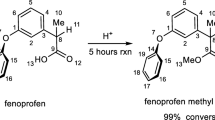Abstract
Purpose
Photoisomerization of the E/Z-alkene structures of drugs is a matter of concern as it could result in potency loss and adverse side effects. This study focused on light-induced isomerization of sulindac and ozagrel hydrochloride catalyzed by concomitant vitamin B2 under light-emitting diode (LED) or fluorescent light.
Methods
In the presence of 0.05/0.03 equivalents of vitamin B2/flavin adenine dinucleotide (FAD), sulindac or ozagrel hydrochloride was irradiated with LED light (405 nm) or fluorescent light. The photoisomerization in CD3OD and D2O was monitored by 1H NMR spectroscopy.
Results
Sulindac and ozagrel hydrochloride isomerized in the presence of a catalytic amount of vitamin B2 or FAD under irradiation of 405 nm LED light and fluorescent light. Irradiation with LED light was found to be more effective than fluorescent light irradiation. The rate of photoisomerization was affected by the solvent, and the reaction in CD3OD proceeded faster than in D2O. Furthermore, ozagrel hydrochloride was more prone to isomerization than sulindac.
Conclusion
The catalytic activity of vitamin B2 or FAD was demonstrated in the photoisomerization reaction of sulindac and ozagrel hydrochloride. Considering that the rate of photoisomerization in D2O is very slow, the possibility of the occurrence of photoisomerization during clinical use is low. However, this study suggests that the interfusion of vitamin B2 or FAD under excessive light exposure should be avoided as a caution during intravenous administration of sulindac or ozagrel hydrochloride.














Similar content being viewed by others
References
Moore DE. Principles and practice of drug photodegradation studies. J Pharm Biomed Anal. 1987;5:441–53.
Albini A, Fasani E. Drugs: photochemistry and photostability. In: Albini A, Fasamo E, editors. Photochemistry of drugs: an overview and practical problems. Cambridge: Royal Society of Chemistry; 1998. p. 1–73.
Beijersbergan van Henegouwen GMJ. Medicinal photochemistry: phototoxic and phototherapeutic aspects of drugs. Adv Drug Res. 1997;29:79–170.
Nudelman NS, Cabrera CG. Isolation and structural elucidation of degradation products of alprazolam: photostability studies of alprazolam tablets. J Pharm Sci. 2002;91:1274–86.
Andrisano V, Gotti R, Leoni A, Cavrini V. Photodegradation studies on atenolol by liquid chromatography. J Pharm Biomed Anal. 1999;21:851–7.
Mohamed A, Salama A, Nasser WS, Uheida A. Photodegradation of ibuprofen, cetirizine, and naproxen by PAN-MWCNT/TiO2−NH2 nanofiber membrane under UV light irradiation. Environ Sci Eur. 2018;30:47.
Li P, Ge P, Ping S, Lin W, Zhang X, Wei C, et al. Photodegradation mechanism and influencing factors of asthma drug salmeterol under UV irradiation. J Photochem Photobiol A. 2021;404:112914.
Maquille A, Salembier S, Hérent M-F, Jiwan J-LH. Photodegradation of flupentixol in aqueous solution under irradiation at 254 nm: identification of the photoproducts generated. J Photochem Phtobiol Chem. 2010;214:224–9.
Wilson S, Ruenitz PC. Structural characterization and biological effects of photocyclized products of tamoxifen irradiation. J Pharm Sci. 1993;82:571–4.
Dall’Acqua S, Vedaldi D, Salvador A. Isolation and structure elucidation of the main UV-A photoproducts of vandetanib. J Pharm Biomed Anal. 2013;84:196–200.
Tashtoush BM, Jacobson EL, Jacobson MK. UVA is the major contributor to the photodegradation of tretinoin and isotretinoin: implications for development of improved pharmaceutical formulations. Int J Pharm. 2008;352:123–8.
Utsuki T, Imamura K, Hirayama F, Uekama K. Stoichiometry-dependent changes of solubility and photoreactivity of an antiulcer agent, 2′-carboxymethoxy-4,4′-bis(3-methyl-2-butenyloxy) chalcone, in cyclodextrin inclusion complexes. Eur J Pharm Sci. 1993;1:81–7.
Kumar N, Windisch V, Ammon HL. Photoinstability of some tryphostin drugs: chemical consequences of crystallinity. Pharm Res. 1995;12:1708–15.
Metternich JB, Gilmour R. A bio-inspired, catalytic E → Z isomerization of activated olefins. J Am Chem Soc. 2015;137:11254–7.
Drugs@FDA: FDA-Approved Drugs: https://www.accdssdata.fda.gov/scripts/cder/daf/. accessed Feb. 2
Kawabata K, Akimoto S, Nishi H. Cis–trans isomerization reaction of sulindac induced by UV Irradiation in the aqueous media. Chromatography. 2018;39:139–46.
Shuman RF, Pines SH, Shearin WE, Czaja RF, Abramson NL, Tull R. A sterically efficient synthesis of (Z)-5-fluoro-2-methyl-l-(p-methylthiobenzylidene)-3-indenylacetic acid and its S-oxide, sulindac. J Org Chem. 1977;42:1914–9.
Olpp T, Brückner R. Stereoselective preparation of (E)-a-bromo acrylates from mixtures of brominated Ando phosphonates. Synthesis. 2004:2135–2152.
Ugolnikov O, Ivanov S, Rannoux C, Salit A-F, Gander S, Thuilliez A-L. 1,3-Dipolar compound bearing an imidazole function. Ala; 2015. p. WO2015059269.A1 2015-04-30
Yamada YM, Yuyama Y, Sato T, Fujikawa S, Uozumi Y. A palladium-nanoparticle and silicon-nanowire-array hybrid: a platform for catalytic heterogeneous reactions. Angew Chem. 2014;126:131–5.
Peng J, Li F, Liang S, Huang Q. Preparation of cis-ozagrel. 2019. CN 110028454 A. 2019-07-19
ACKNOWLEDGMENTS AND DISCLOSURES
The authors declare that they have no conflicts of interest.
Funding
This work was supported in part by a Grant-in-Aid for Young Scientists (19K16454) from the Japan Society for the Promotion of Science.
Author information
Authors and Affiliations
Contributions
Mayuko Suga, Kosho Makino, and Hideyo Takahashi contributed to the study conception and design. Material preparation, data collection, and analysis were performed by Mayuko Suga, Kosho Makino, Hidetsugu Tabata, Tetsuta Oshitari, Natsugari Hideaki, and Hideyo Takahashi. The first draft of the manuscript was written by Mayuko Suga, Kosho Makino, and Hideyo Takahashi. All authors read and approved the final manuscript.
Corresponding author
Additional information
Publisher's Note
Springer Nature remains neutral with regard to jurisdictional claims in published maps and institutional affiliations.
Rights and permissions
About this article
Cite this article
Suga, M., Makino, K., Tabata, H. et al. Photoisomerization of Sulindac and Ozagrel Hydrochloride by Vitamin B2 Catalyst Under Visible Light Irradiation. Pharm Res 39, 577–586 (2022). https://doi.org/10.1007/s11095-022-03203-3
Received:
Accepted:
Published:
Issue Date:
DOI: https://doi.org/10.1007/s11095-022-03203-3




